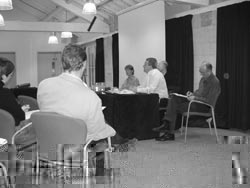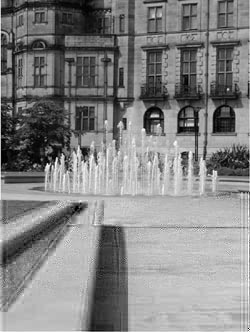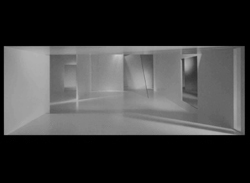PASW Regional Newsletter: Spring 2004
Regional Network Meeting Report
Time for change? public art practice within local authorities.
Swindon, November 2003
Maggie Bolt welcomed everyone to the meeting, saying how delighted she was to be holding it in Swindon , as this was the first opportunity to host an event in Wiltshire, as part of the new regional area. She thanked Swindon Borough Council's Artscape for collaborating with PASW on the event, and STEAM who had provided the excellent meeting facilities and offered delegates an opportunity to visit the museum at a reduced rate.
The subject of today's event, she said, was to explore public art activity within a local authority context. Public art is a constantly evolving and changing area, and as such, any strategy or policy instigated by a local authority, needs to make provision for reviewing, modifying and refining its approach and aims, in order to be able to assess whether it is being successful. We all need to take time out from the daily focus on delivery, so that we can evaluate our work practices and learn from them.

Network Meeting, Swindon, November 2003
Maggie went on to say that the meeting offered an opportunity to hear how three local authorities had or will be taking a step back, in order to look at their public art practice, question current attitudes and procedures, and develop ways of working which fully meet their aims and objectives. She then handed over to the meeting's Chair, Andrew Kelly.
Andrew re-iterated Maggie's welcome to the meeting and said that the subject being explored today represented a crucial area of public art development. He ran through the format of the day, and concluded by saying that he hoped that the speakers would be able to inspire others. Andrew then introduced Paul Swales.
Paul Swales started by saying that the driving force behind Sheffield 's adoption of a public art policy was that this area of activity was 'about to go down the pan'. He talked about his ten year period as the Public Art Officer, and the controversial but hugely successful £5m project, Sheffield Peace Gardens, which re-energised the city. The review of the public art policy was a result of the momentum generated by the Peace Gardens project. Although it did not actually take place until after he had left his post, people acknowledged that if the city was carrying out public art work which was undeniably delivering benefits, then there was a need to understand fully the process and outcomes involved.

Peace Gardens, Sheffield.
Artists: Brian Asquith, Tracey Hayes, Richard Perry and Andrew Skelton.
Photo: Paul Swales
A key area which arose out of the review, was that the authority should not focus on commissioning 'single pieces of work'. Rather, it should recognise the importance of bringing artists in at the beginning of the development process and the need to create a framework for encouraging good practice; it is this 'framework' which creates a starting point for conversations between the authority and developers.
Percent for Art was also reviewed, offering an opportunity to explore ways in which the money could be spent more effectively. On the back of this work a decommissioning strategy was also developed. Paul talked about public art activity in the city resulting from economic regeneration schemes and the role of public art, with regard to realising the notion of creating identities for particular areas of the city. He viewed temporary interventions as being linked to the 'cutting edge'.
He went on to talk about various initiatives: the city's Public Art Forum, the Symposia initiative 'Stone City' which invited artists to come and work in the city, and the work carried out by Melanie Jordan and Andy Hewitt on developing new audiences.
As a result of the review, an action plan was created, which specified key targets. The plan is now being implemented through the infrastructure of the city's Planning department. This includes reviewing how public art is integrated within the regional planning guidance and UDP. Paul reported that the Regional Planning Guidance 12 was currently under review and should the proposed changes be implemented, greater support would be forthcoming for public art policies integrated within the local plan.
Andrew thanked Paul for his presentation and invited questions from the delegates. Issues that were discussed included:
- how public art funding can encourage and develop artists' communities within towns and cities.
- the pooling of funds for Percent for Art and private sector funds.
- low maintenance and vandalism issues within artists briefs and whether they meant a constraint or challenge for artists.
Andrew then introduced Andy Thompson, a Planner and Urban Designer who had become involved in public art within the last couple of years. Consequently, he was currently involved in developing a public art strategy for the City of Cambridge.
He talked briefly about Cambridge, a city with a population of 108,880, which had been awarded 'Beacon' status for design, and which was now under huge pressure to develop. The city, he said, was home to a number of notable arts organisations and the regional Arts Council. The arts responsibility within the city council was spread around a number of departments with the Public Art Plan being adopted by the Environment Department. Andy then showed a number of slides of the artworks already in existence in the city in order to contextualise the developing approach to public art. A Percent for Art policy had been adopted in 1992. It became part of the local plan in 1996, yet it wasn't until 2002 that the Public Art Plan, written by Commissions East, was approved. Andy went on to explain that decision-making in relation to the Plan is devolved to a Public Art Steering Committee that meets every six months. The Committee is responsible for guiding the strategy, overseeing reviews, identifying opportunities and resources, and acting as advocates for the work.
Andy talked about the provision of public art as part of new development schemes, which was achieved via Supplementary Planning Guidance, which was adopted by the city council in July 2002. He described the aims of SPG, the definitions, eligibility, and the financial obligations. He outlined how Section 106 Agreements secure and enforce Percent for Art schemes. Progress to date, he said, was positive. Supplementary Guidance has been applied to 35 applications, resulting in securing, via Section 106 Agreements, public art activity. In addition, developers' interest was increasing with time and increased implementation was starting to come through.
Andy then described the purpose of the Public Art Initiatives Fund, whereby the council would accept a commuted sum equivalent to 1% of construction costs via a planning obligation. A number of first projects had been identified. Quality control is introduced to this process through the Conservation and Design Panel who assess all applications to the Fund.
He then talked about the proposed Public Art Audit that the Steering Committee were keen to carry out and provided information on a new public art commission the city was involved in called 'The Junction', a major city centre re-development. He was even able to announce who the winners were of the artists' competition, news which was hot off the press!

The Junction, Cambridge
Andy concluded his presentation by presenting some of the public art commissions which had taken place in Cambridge:
- community arts projects
- capital projects, delivered by the city and County Council in partnership
- environmental improvement projects
Having thanked Andy for his presentation, Andrew asked for questions from the audience. A number of questions were asked covering issues of:
- how to generate strong membership support within councils
- how a public art requirement works alongside others within SPGs
- issues over quality control with regard to commissioned work
Celia Yeoman was then introduced. Celia began by supplying some background information on the work of Artscape, which covers a whole range of work including public art. In 1988, she said, a Public Art Policy was adopted and a senior officer post created, in order to deliver the work. Over the next few years a Public Art Unit was established and a large number of works commissioned. Celia showed slides of some of the work, and talked about the survey she had recently carried out, which catalogued the work and its current physical state. The involvement of the planners has, she said, been paramount to the success of the council's Percent for Art policy, which is embedded within the Local Plan. So where is Swindon now? Public art activity is still actively taking place, she said, with 19 projects currently in progress. Celia then showed slides of Grennan and Sperandio's 'Celebrating Swindon' project, along with work at Swindon Arts Centre and the Great Western Hospital. But, despite the successes. why does it still feel like an uphill battle? In response to these questions, Celia listed what she saw as the challenges facing public art development within the authority:
- stakeholders' lack of commitment
- internal protocol
- paucity of budget
- developers still required convincing
- creative commissioning was not the 'norm'
- elected members still required a great deal of advocacy work
- the general public needed to be made aware of the benefits
- vandalism, an ongoing problem for the city in general
Celia said that an effective communication system was needed, internally and externally, coupled with an ability to utilise resources more effectively. She also needed to devise ways in which to further support the developers, enthuse councillors, engage young people and inform and involve the public. After 15 years of operating a public art policy, she said, it was time to carry out a review, and take a strategic overview of projects, if Swindon was going to be able to develop and sustain further activity. Whilst the authority had a track record of delivering good work, it must not become complacent.

Blue Manifold, Swindon
Artists: Leon Palmer and Anna Heinrich
Photo: Leon Palmer
Celia finished by talking about the wider picture, with regard to national government initiatives, education, training for artists, and the regeneration agenda.
Andrew thanked Celia for her contribution to the meeting and then invited questions. Questions asked raised issues concerning:
- the New Swindon Company, its remit and role
- the engagement of the community within the regeneration process
- the need for developing and providing training for local artists.
- maintaining quality of work by not passing the responsibility of commissioning to other agencies
- what can prevent vandalism?
After a break for tea, Andrew welcomed everyone back to the plenary session. He started the discussion off by asking what advice Paul and Andy would offer Celia as she embarks upon her review. Paul stated that it was essential to celebrate achievements, but also to be critical in terms of progress to date. From his experience one should acknowledge that sometimes it is necessary to adopt a 'do less better' policy. Andy highlighted the need to take people with you, throughout the review process and not to be afraid of making mistakes.
Andrew then threw open the discussion to the floor, and invited questions and comments. A lively discussion took place, which covered the following issues:
- persuading councillors to take art seriously and how their involvement in commissioning selection panels could encourage them to become supportive stakeholders
- vandalism as an issue could not be solely laid at the door of public art as it affected all areas of public life; wider strategies with regard to engaging communities had to be adopted by the council
- long term liability for work, and how important it was that the maintenance of work was fully acknowledged by the commissioner and that clear decommissioning policies were written and adhered to. It was suggested that the authority should be the body to set a benchmark for this
- the pooling of money for maintenance funds
- whether using Section 106 agreements to secure money for public art was too late in the process, with regard to securing the artists' early involvement.
Andrew thanked all the speakers for their presentations and the delegates for their contributions. Maggie then concluded by saying that the public art policies under discussion could be found on PASW's website, www.publicartonline.org.uk, along with a range of other useful material, particularly in relation to local authority activity. She stressed that PASW was able to help with many of the issues, which had been raised and encouraged people to make contact. She then briefly described the topic for the next Regional Network meeting, which was the artists' role in regeneration projects and multi-disciplinary working. This would be in collaboration with Public Art Forum and would take place on April 22nd 2004 in Bristol . She then thanked everyone for coming and the meeting closed.
Lisa Harty
Network Co-ordinator, on behalf of PASW
